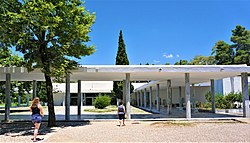Archaeological Museum of Olympia
Archeological museum in Greece From Wikipedia, the free encyclopedia
Archeological museum in Greece From Wikipedia, the free encyclopedia
The Archaeological Museum of Olympia (Greek: Αρχαιολογικό Μουσείο Ολυμπίας) is one of the principal museums of Greece, located in Olympia. It is overseen by the Ministry of Culture and Sports, and, as of 2009, is directed by Georgia Xatzi. When the original building was completed and opened in 1888, it was the first museum in Greece outside of Athens.
 | |
 | |
| Established | 1982 (New museum) |
|---|---|
| Location | Ancient Olympia, Elis, Greece |
| Type | Archaeological museum |
| Website | ancientolympiamuseum |
The museum houses discoveries from the surrounding area, including the site of the Ancient Olympic Games. The collection includes objects produced and used in the area from prehistory to its time under Roman rule. The principal pieces in the museum are Hermes and the Infant Dionysus (attributed to Praxiteles), some objects from the Temple of Zeus, the Nike of Paionios, as well as an oenochoe that belonged to Phidias. The extent of its bronze collection makes it one of the most important in the world.
Today, the museum is housed in two buildings: the principal building with twelve rooms for exhibitions, organized both around themes and ages of the objects. The other building is dedicated to the museum store, and is separate from the main structure, located on the path to the archaeological site.
Excavation work at Altis in the 19th century quickly necessitated the construction of a building to display unearthed objects and works of art. The banker Andreas Syggros spent 220,000 drachmas to fund the building and entrusted design and construction to two German architects and archaeologists who had begun excavating the site. Wilhelm Dorpfeld and Friedrich Adler, the architects, oversaw construction of a neo-classical building which was erected on the hill of Drouva near the road from Olympia to the sanctuary. Completed in 1888, it was the first Greek museum built outside of Athens. It was damaged in 1954 by an earthquake, and later proved too small to house and display the museum’s expanding collections. Plans to build a new museum were approved in the 1970s. Although it was unused for some time, the original building was re-purposed; since 2004, it has been a museum about the history of the original Olympic games.[1]

The statue of Apollo from the west pediment of the Temple of Zeus was depicted on the obverse of the Greek 1000 drachmas banknote of 1987-2001.[2]
Seamless Wikipedia browsing. On steroids.
Every time you click a link to Wikipedia, Wiktionary or Wikiquote in your browser's search results, it will show the modern Wikiwand interface.
Wikiwand extension is a five stars, simple, with minimum permission required to keep your browsing private, safe and transparent.